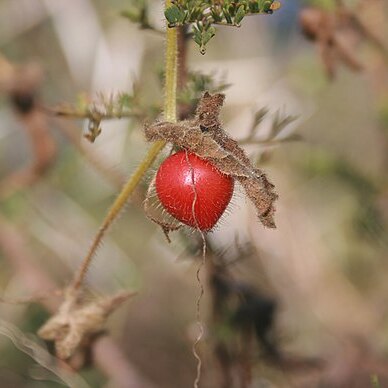Perennial herb; viscid-glandular, foetid when crushed. Stems procumbent or climbing. Tendrils simple. Leaves petiolate; green; blade undivided, ovate to broadly ovate, base cordate, margins faintly 3-5-lobed with short, obtuse lobes; petioles up to 10 mm long. Flowers: male peduncles and pedicels slender, peduncles up to 30 mm long; corolla 2-5 mm long, hairy or papillose-hairy, cream-coloured, yellow or greenish yellow; Dec.-May. Fruit globose, 9-13 mm long, pilose; seeds asymmetrically ovoid, 4.0-5.0 mm long.
A pumpkin family plant. It is a herb and a climber. The tendrils are usually unbranched. It has a strong unpleasant smell. It has a tuberous root. The leaf stalk is 1 cm long. The leaf blade is triangle shaped. It can have shallow lobes. There can be teeth along the edge. Both flower sexes are usually on the same plant. The flowers are a few and in small stalked clusters. Flowers are bell shaped and white. The fruit are fleshy and have a few seeds. The fruit are pear shaped and 3 cm long. They occur singly.
Leaf-lamina 1·6–9 × 1·6–10·2 cm., narrowly to broadly ovate in outline, cordate or subhastate, obscurely sinuate-denticulate to almost entire, rather thin, bright green, rather sparsely to densely shortly finely hispid above and beneath, unlobed or incipiently to moderately deeply palmately 3–5-lobed, central lobe much the largest, ovate to triangular, obtuse to rounded, shortly acuminate, apiculate; petiole 0·4–5·2 cm. long, hispid, glandular.
Scandent or prostrate herb or climber, viscid-glandular and foetid when crushed. Tendrils simple. Male peduncles slender, similar to pedicels. Fruits pilose, ovoid-rostrate to subglobose, 9-13 x 5-7 mm. Seeds asymmetrically ovoid, 4.3-5.1 mm long. Flowers cream, yellow or greenish yellow.
male flowers 3–15 in small axillary fascicles or racemes, rarely solitary; peduncles 4·5–30 mm. long, slender; pedicels 3–14 mm. long. Receptacle-tube 1·5–3·5 mm. long; lobes 0·8–2·5 mm. long, lanceolate-subulate. Petals 2–5 mm. long, cream, yellow or greenish-yellow.
Female flowers solitary; pedicels 1–3·5 mm. long; ovary 2·5–4 × 0·7–1·5 mm., ellipsoid, rostrate, densely finely pilose; receptacle-tube 1·3–2 mm. long; lobes 0·8–1·2 mm. long, triangular-lanceolate to lanceolate-subulate, acute; petals 1·5–3 mm. long.
Fruit 9–13 × 5–7 mm., ovoid to subglobose, rostrate or erostrate, finely pilose, pale green with darker longitudinal lines becoming orange then red when ripe, indehiscent; pedicel 1·5–9 mm. long.
Seeds 4·3–5·1 × 2·8–3·7 × 2–2·2 mm., asymmetrically ovate in outline, smooth, dark-coloured, bordered, rounded at the base, compressed and shortly 2-lobed at the apex.
Stems to 3 m., prostrate or scandent, rather densely crispate-setulose, glandular, when old developing a thin pallid bark.
Flowers monoecious, male and female usually co-axillary.
Rather viscid tuberous-rooted herb, foetid when crushed.
Fruit scarlet or crimson when ripe.
Tuber napiform, with rugose bark.
A climber, up to 8 ft. high
Flowers small, yellowish
An unpleasant smell
Tendrils simple.

